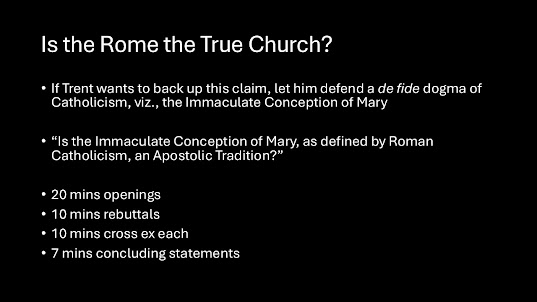Trent Horn, after embarrassing himself against fellow LDS apologist (and friend) Jacob Hansen, released a new video, based on his opening statement:
5 Reasons to Doubt the Book of Mormon
If you have not, be sure to watch the review I had the day of the debate (I was joined first by Stephen Smoot then later, Blake Ostler):
Review of the Jacob Hansen/Trent Horn Debate
I know Trent follows my blog, and as he repeats the bogus "Rome is true, ergo, Book of Mormon is false" argument (argument no. 4 in his opening statement against Jacob), he can consider the following an open debate challenge on a de fide dogma of Rome, viz., the Immaculate Conception and whether it is apostolic in origin. Here is the slide I shared on my review:
As an aside, Horn repeats the claim that the Book of Mormon presents the New World as a vacuum and that there were no indigenous populations incorporated into the text (notwithstanding how quickly Lamanite and Nephite became generic, not genetic, terms [see Jacob 1:13-14]).
For refutations, see, for e.g.
John L. Sorenson, "When Lehi's Party Arrived in the Land, Did They Find Others There?"
John Gee and Matthew Roper, "'I did liken all scriptures unto us': Early Nephite Understandings of Isaiah Implications for 'Others' in the land"
To quote one relevant source, consider the following from Blake Ostler who provided the following example based on a careful reading of Helaman 5-7:
In Helaman 5, Mormon notes that “the more part of the Lamanites were convinced of [the truth] because of the greatness of the evidences which they had received.” (Helaman 5:50) As a result, “the Lamanites had become the more righteous part of them, a righteous people, insomuch that their righteousness did exceed that of the Nephites, because of their firmness and their steadfastness in faith” (Helaman 6:1). The Lamanites began to move freely among the Nephites, traveling to the Nephite city of Zarahemla so that “the Lamanites did also go withersoever they would, whether it were among the Lamanites or among the Nephites, and thus they did have free intercourse one with another” (Helaman 6:8).
In the midst of this openness among the Lamanites and Nephites, Nephi, the son of Helaman, goes northward among an unnamed people to preach to them. Indeed, not only Nephi but also the Lamanites go to the “people in the land northward” to preach: “And it came to pass that many of the Lamanites did go into the land northward; and also Nephi and Lehi went into the land northward, to preach to the people” (Helaman 6:6). However, these “people in the land northward” are so wicked that Nephi cannot remain among them.
There are two crucial points about Nephi’s missionary activities: (1) the text does not name the people to whom he preached but was rejected; and (2) these people are neither Nephites nor Lamanites because the Lamanites had become righteous and willingly accepted the gospel and went to preach to these people also. While the Nephites and Lamanites move freely through each other’s lands in a climate of peace, the people to whom Nephi goes are so antagonistic that he cannot remain among them:
Now it came to pass in the sixty and ninth year of the reign of the judges over the people of the Nephites, that Nephi, the son of Helaman, returned to the land of Zarahemla from the land northward. For he had been forth among the people who were in the land northward, and did preach the word of God unto them, and did prophecy many things unto them; And they did reject all his words, insomuch that he could not stay among them, but returned again unto the land of his nativity. (Helaman 7:1–3, emphasis added)
The text twice refers to those to whom Nephi and the Lamanites preached not as Lamanites but as “the people in the land northward.” Why doesn’t the text just say that Nephi went to the Lamanites and that the Lamanites rejected him as it does virtually every other time that a Nephite goes to preach to Lamanites? It is fairly clear that in this instance, “the people who were in the land northward” are not Lamanites. We know this because the text states that the Lamanites had become righteous and many had accepted the gospel, and the Nephites had great missionary success among them. So who are these “other” people in the land northward who had rejected Nephi and the Lamanites? The text doesn’t say—but because those who rejected Nephi are neither Nephites nor Lamanites, it has to be a third group of people that remains unnamed in the text. (Blake Ostler, DNA Strands in the Book of Mormon, Sunstone 137 [May 2005]: 65)
To Support this Blog:
